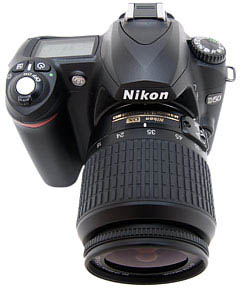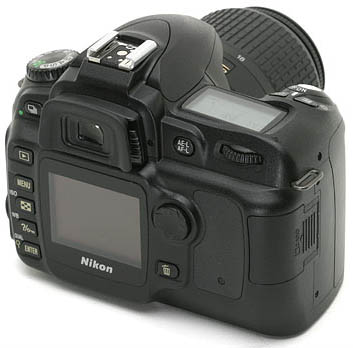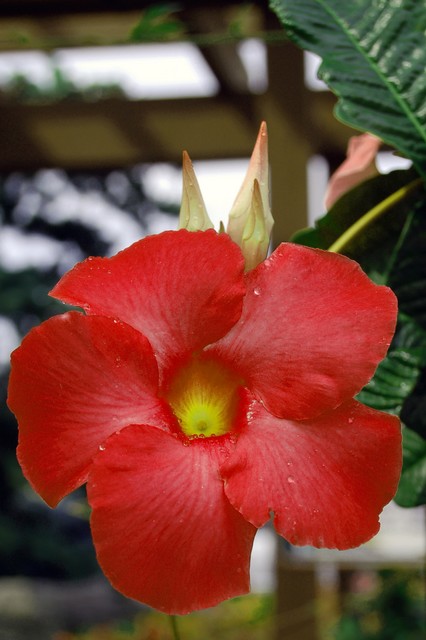Nikon D50

I'd get one here or I'd find a good one on eBay.
Introduction
The Nikon D50 body was introduced after the D70 but before the D80. It is now discontinued but is still a highly affordable used camera that is a great way to get into the DSLR-game. It is also a great camera to pick up if you already own a higher-end Nikon body and you would like a spare body or a body to keep a second lens on so you don't have to swap lenses as much in the field.
Specifications
Maximum Resolution: 6MP (3,008 x 2,000)
Minimum ISO: 200 - This is okay. I like ISO 100 sometimes for studio things, but 200 is perfectly acceptable.
Maximum ISO: 1,600 - again, this is fine. It starts to get noisy above ISO800, and having ISO1600 helps a lot for darker indoor settings. Here's a trick: if your ISO produces too much noise, just convert the photo to black and white and the grain makes it more "artistic."
Vertical Grip: NO. There are off-brand makers from Asia that claim to have vertical grips. Stay away from them since there is no coupling to permit firing the shutter from the grip. All of these grips use un-reliable IR connections.
Meter weird lenses: NO - Why can't Nikon do this on their less-expensive cameras?
AF works with AF lenses: YES - Like a real camera should!
Memory Card Type: SD and SDHC
Top LCD Illumination: No - Not a biggie unless you shoot mainly in the dark and don't bring a flashlight with you.
Shutter speeds: B, 30-1/4,000. 1/4,000 is plenty. The
 only time you'd consider more than that is if you took
your
50mm f/1.4D
lens outside on a sunny day and shot it wide-open (f/1.4) with an ISO
at like 800 or more. And that's a crazy thing to do in
the first place.
only time you'd consider more than that is if you took
your
50mm f/1.4D
lens outside on a sunny day and shot it wide-open (f/1.4) with an ISO
at like 800 or more. And that's a crazy thing to do in
the first place.
Maximum Frame Rate: 2.5fps. This is acceptable. It is lighting fast compared to your pocket-sized Point-And-Shoot, but slower compared to many other Nikon DSLR products.
Buttons and dials: Adequate. You can control "everything" you need to, but many things are only accessible via on-screen menu options or you have to hold one button while you turn a dial. Other Nikon cameras have more buttons and dials so you have better immediate control. The plus is that if you're new to the game, there's less to screw up or bump. The minus is that you can quickly out-grow this body and find that fine-tuning is cumbersome. If this is a second body to keep as a "spare" then the savings to you of fewer buttons/dials is fine since you likely won't be using this camera more than 15% of the time.
Modes: M,A,S,P, Auto, Landscape, Portrait, Sports, Kid, Macro, and Night. Having the scene modes is nice if you're just getting started. Full Auto is nice as a "PHD" mode (Push Here, Dummy) or "waiter" mode so you can hand your camera to someone else to take a photo of you. Hopefully you'll quickly out-grow the canned modes and shoot more in something like "A" where you gain more control over the image, but still rely on the camera to do most of the thinking for you.

Performance
Overall, this is a handy little camera to have around.
I like it today for use with my Sigma 10-20mm wide-angle lens since if I'm shooting super wide I likely won't be cropping the image, so 6MP is great. Another reason that it marries nicely to the Sigma 10-20mm is that when I shoot wide I tend to shoot landscape, and since I can't get a vertical grip for this body this isn't a problem.
For all other aspects of photography it does a fine job and I'm sure you'll like it. As I previously mentioned, the lack of a full set of buttons and dials means that if you're new to the DSLR-game then you have less things to bump or worry about, but if you use it a lot you'll quickly outgrow it.
The 6MP and ISO 1,600 might sound low compared to all of the new offerings today, but MP ratings are more hype than actual usable performance numbers. And ISO 1,600 is higher than what I use for 90% of the photos I take. Yes, having higher is nice at times, but it isn't a deal-breaker.
Alternatives
The D40 (and D40x) are a step sideways from the D50. They are both newer and have a higher megapixel ratings but neither can focus with regular, popular, and affordable AF lenses. So, while they have higher ISO tricks what good are they if they can't use a great $100 lens like the 50mm f/1.8D? The D50 also has a better meter in it as I find the D40/D40x to be a more "consumer" kind of meter (consumer: works but not always / a cost savings downgrade).
A step up from the D50 is the D80, which came out soon after the D50. It has a higher megapixel rating, higher ISO capability, and you can get a real vertical grip for it. In fact, I consider the D80 to just be a D200 in sheep's clothing since it has the same sensor in it and everything else that matters is the same. The D50 and the D80 are good complements to each other since they both take the same kind of memory cards. So, if you have a D80 then a D50 would be a welcome addition to your camera bag (and vise versa).
Examples
Following are some sample photos to demonstrate the power of this camera and some general uses which will likely yield good results. If you shoot things like these, then this body may be a good one to think about adding to your camera bag.

